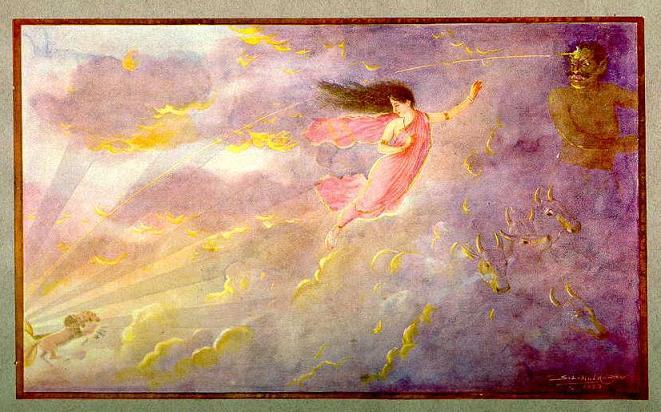srigurubhyO namahA |
The 141st mantrA of the thirumandiram details the process of spiritual progress commencing from initiation through to contemplation and finally absorptive concentration.
The 141st mantrA of the thirumandiram details the process of spiritual progress commencing from initiation through to contemplation and finally absorptive concentration.
சந்திப் பதுநந்தி தன்திருத் தாளிணை
சிந்திப் பதுநந்தி செய்ய திருமேனி
வந்திப் பதுநந்தி நாமம்இன் வாய்மையால்
புந்திக்குள் நிற்பது நந்திபொற் பாதமே. I.1.29.141
சிந்திப் பதுநந்தி செய்ய திருமேனி
வந்திப் பதுநந்தி நாமம்இன் வாய்மையால்
புந்திக்குள் நிற்பது நந்திபொற் பாதமே. I.1.29.141
All
they see is Nandi's Holy Feet twain,
All they think is Nandi's Holy Form divine,
All they chant is Nandi's Name, I trow,
In all their thoughts Nandi's golden Words and wise. I.1.29.141
All they think is Nandi's Holy Form divine,
All they chant is Nandi's Name, I trow,
In all their thoughts Nandi's golden Words and wise. I.1.29.141
Com - All
they see is Nandi's Holy Feet twain, Continuously one should unite with the
Holy feet of siva, All they think is
Nandi's Holy Form divine, Continuously one must contemplate His reddish
effulgence, All they chant is Nandi's
Name, I trow, At all times one must keep chanting the name of siva and
singing His praises. In all their
thoughts Nandi's golden Words and wise and in my mind there is nothing but
the knowledge of His holy feet.
*The word ‘sandhippadhu’ in the first line of the
original verse refers to the process of obtaining initiation from the siva
guru. This is the first step through which the yOgin is able to obtain the grace of siva, which is often referred
to as the Holy Feet of siva. As described before, this grace is in the form of
light – the light of siva. So in the first step the disciple receives the grace
on the crown of his head through the guru.The word ‘sindhippadhu’ in the second line translated as think refers to the
practise of observing and experiencing the vibration (spandA) that emanates from the light on the crown of the head. This
exercise cultivates the light body of the aspirant.The word ‘vandhippadhu’ in the third line refers
to the state where all body consciousness is lost (i.e. where the senses are
under control) while immersed in the worship of the holy feet of siva. Again,
as before, the sage speaks in line with the vEdic
idea of assimilation of spiritual knowledge through the stages of shravanA, mananA and nidhidhyAsanA. One must first of all
approach the guru and obtain from him the right initiation through which the
light of siva is obtained on the crown. Then one must strive to experience the spandA at that region and being aware of
nothing else but the holy effulgence of siva, one must remain engaged in the
worship of the Lord. Then one’s consciousness will be pervaded, like that of
our revered thirumUlar, with the pure
light of siva. Nothing but the wisdom of siva.
thirucchitrambalam |
